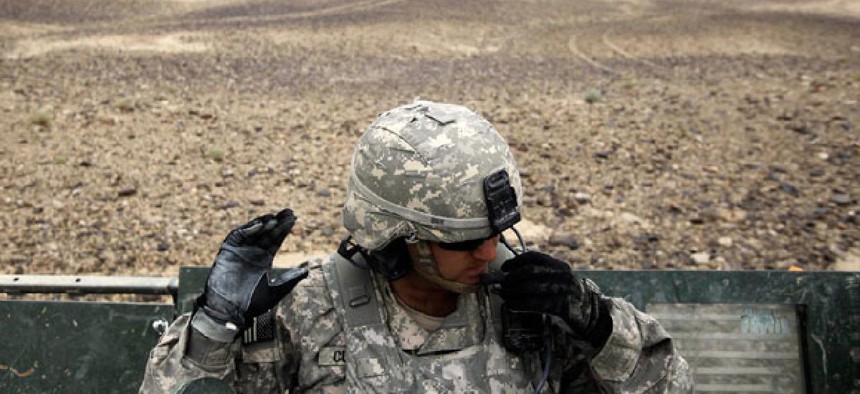Army plans to buy battlefield radio that performed poorly in Pentagon tests

AP file photo
JTRS manpack radio will be fielded to combat brigades deploying to Afghanistan next year.
This story has been updated.
The Army is close to awarding General Dynamics Corp. a low rate production contract for a manpack radio to transmit broadband data on the battlefield, Nextgov has learned.
The service’s plans to buy the radio continue despite a July report by J. Michael Gilmore, director of operational test and evaluation for the Defense Department, deeming it operationally ineffective and unsuitable.
The Army anticipates fielding the Joint Tactical Radio System manpack radio to infantry brigades slated for deployment to Afghanistan in 2013, sources told Nextgov. Service officials plan to buy about 3,800 of the General Dynamics manpack radios at $78,000 each, sources said, for a total cost of $296.4 million.
The JTRS program, started in 1997, stands out as one of the Pentagon’s longest running and most troubled projects, with few radios fielded to date. It was designed to develop a family of radios that use software waveforms rather than hardware to define bandwidth, frequency, modulation, security and data rates. Its casualties to date include a refrigerator-size radio, developed by Boeing Co., whose cost peaked at $15.9 billion before the Pentagon canceled it in October 2011.
General Dynamics won a $295 million contract to develop the handheld and manpack JTRS radios in 2004 and this August, General Dynamics along with Thales Communications were awarded a contract valued at $53.9 million for 13,000 handheld radios, following successful real-world test by Army Rangers in Afghanistan.
JTRS radios need to be booted up like a personal computer to operate. Tests of the manpack in April and May at White Sands Missile Range, N.M., showed it took 20 to 25 minutes to start the radio, Gilmore said in a July 20 memo to Frank Kendall, undersecretary of Defense for acquisition, technology and logistics. The memo was obtained by Nextgov.
Requirements for the General Dynamics manpack, the AN/PRC-155, call for delivery of radios weighing 14.6 pounds with one battery and two antennas. Soldiers at the White Sands test area this spring reported they had to haul two batteries and three antennas, with a total weight of 18.8 pounds, a 4.2 pound increase over the target weight.
The manpack Single Channel Ground and Airborne Radio System (SINCGARS) waveform tested at White Sands demonstrated less than half the range of older legacy radios, Gilmore said -- seven kilometers versus 20 kilometers. SINCGARS voice quality on the General Dynamics radio “was often poor, garbled and unintelligible,” he added.
Tests at White Sands also revealed the radio generated too much heat, Gilmore said. “Soldiers reported during the test that the radio was too hot to touch and they could not remove it from its protective carrier due to excessive heat,” he said.
Gilmore said General Dynamic’s radios running the new Soldier Radio Waveform performed well at White Sands and “demonstrated an operationally useful capability to support multiple talk groups on a single channel. For example, the company commander could operate the company command network, fires network and administration/logistics network on a single . . . channel.”
The Army currently is running development tests on the manpack radio at the Electronic Proving Ground at Fort Huachuca, Ariz. Chris Marzilli, president of General Dynamics C4 Systems, told Nextgov, “we look forward to the current developmental test results at Fort Huachuca to validate the effectiveness of the updates we’ve made to the manpack.”
The Army is supposed to send Kendall the results from those tests in the first week of October, sources told Nextgov. Kendall then will decide whether or not to proceed with low rate production. Bets are he will give the go-ahead, the source said.



